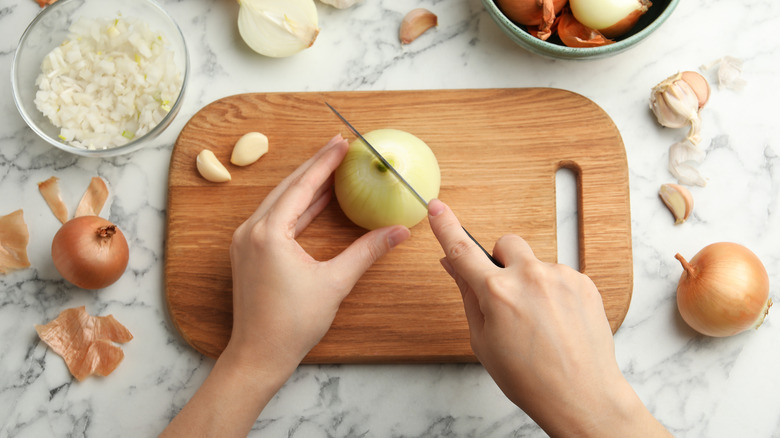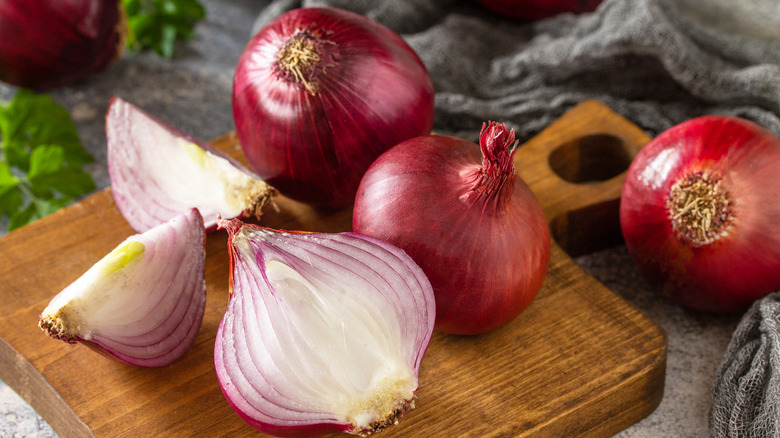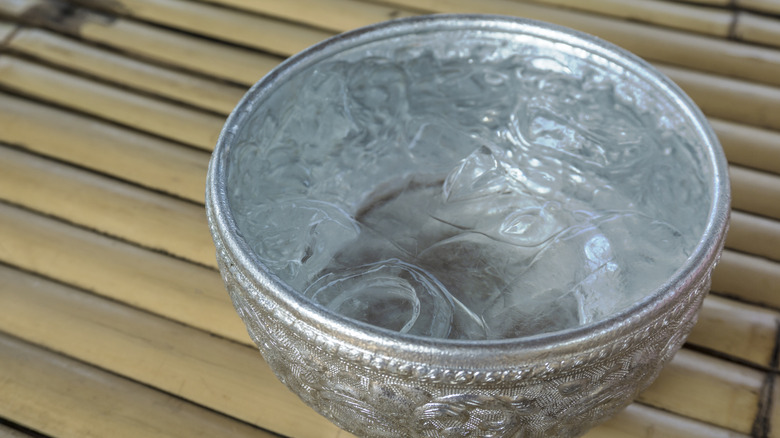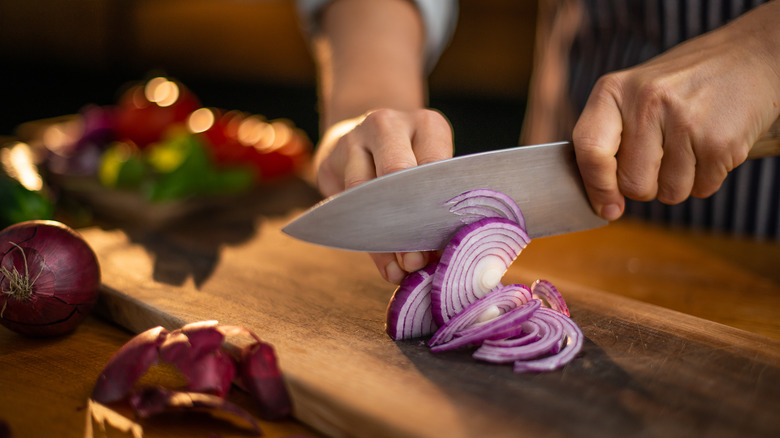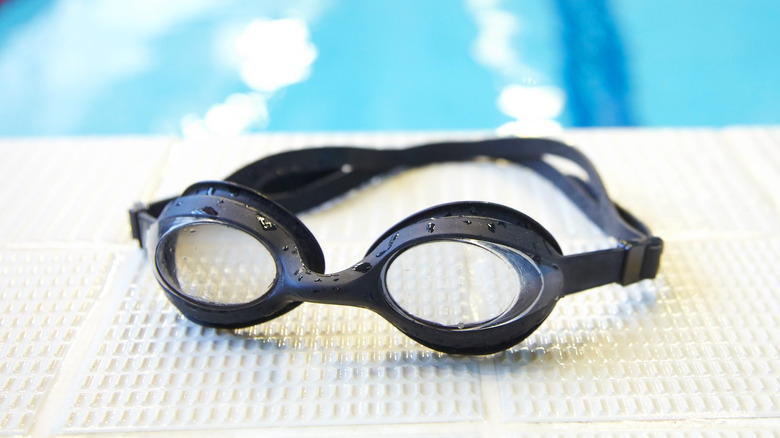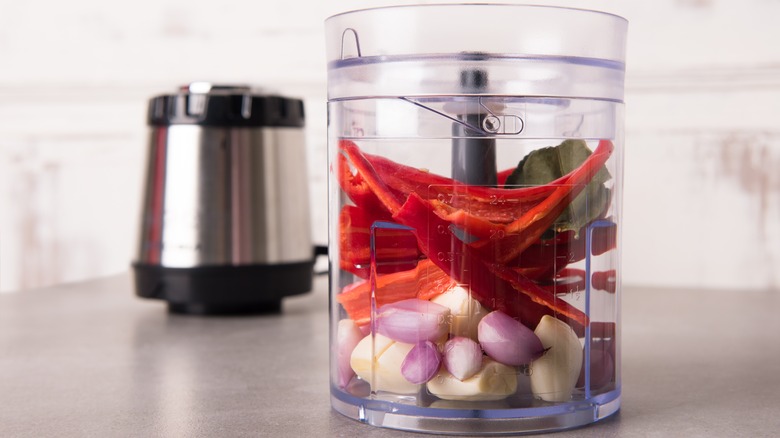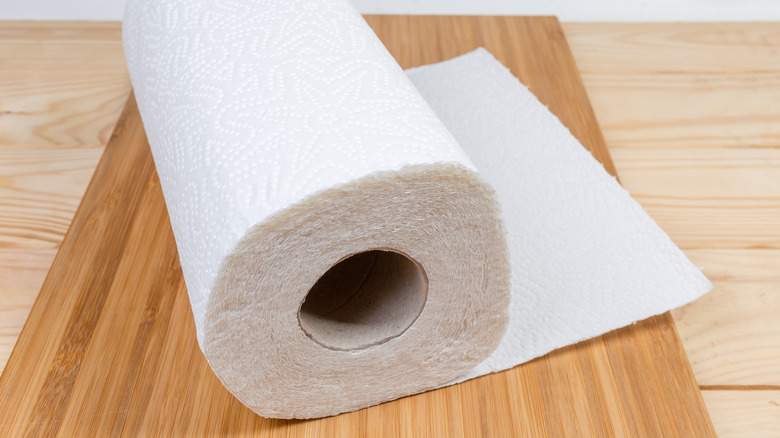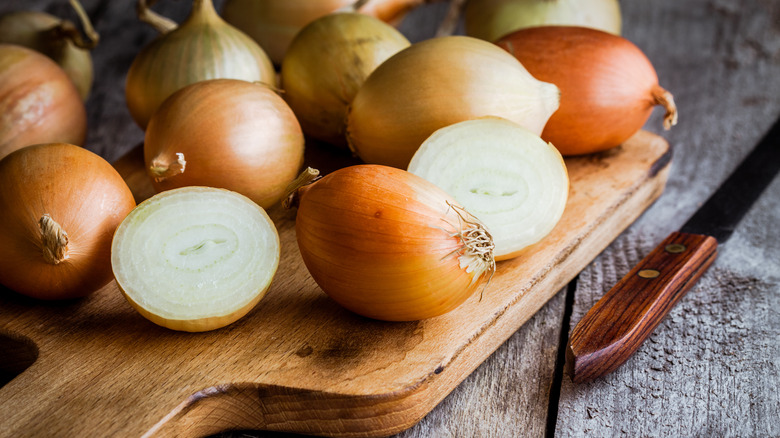How To Chop An Onion And Not Cry
We have a joke in our household that every recipe begins with an onion and then we decide what other ingredients we are going to eat along with it. The onion, which is a member of the allium family of plants, is an integral part of many recipes, making its natural defense mechanisms rather inconvenient to chefs and allium lovers alike (via NPR). That's right, the onion isn't trying to make us cry; it's trying to protect itself from being destroyed. If we were looking at it through an evolutionary lens, we'd almost think the onion was a sentient being.
Indeed, onion cells contain tiny globules of enzymes that are ready to spring into action the moment the cell's structure is compromised by either a hungry animal or a chef's knife. These disrupted globules produce a chemical reaction that emits an irritant known as syn-propanethial-S-oxide. This chemical is what is called a lachrymatory agent, meaning it makes us cry, per Healthline. The second this chemical interacts with the water on your eyes, it turns into sulfuric acid. And because our eyeballs are equally as clever as the onion is, they spring into action to protect us by making us a blubbering mess.
If you think about it, it kind of makes you feel a bit guilty for wanting to eat an onion — but not quite guilty enough to stop doing so because they are delicious. With that in mind, we wanted to explore the litany of methods for cutting an onion without tears. Some have sound scientific bases, while others are dubious.
Buy fresh onions
Before delving into the ways in which we can circumvent the onion's natural defense mechanisms, we wanted to look at how we could simply avoid them. According to Insider, one of the first lines of defense is to consume onions that are fresh as opposed to those that have been stored for extended periods of time. As an onion deteriorates, the enzymes within its cellular structure also begin to break down, and the blast of tear-inducing chemicals is worse when disrupted.
Additionally, the type of onion you purchase may matter. Healthline notes that red, yellow, and white onions are the greatest tearjerkers thanks to their high sulfur content. Sweeter onions, like Vidalias or Walla Wallas, are far milder and less aggressive due to their lower sulfur content. Healthline also suggests alternatives like purchasing pre-cut onions at the store, using onion powder, opting for an allium that isn't lachrymatory (such as a chive, green onion, leek, or garlic), and substituting other crunchy vegetables for texture in salads.
Or, you can now find an onion that has been hybridized to not have this natural defense mechanism, known as the Sunion. This tear-free varietal of onion is three decades in the making and is grown under careful supervision in Washington and Nevada. While they are in limited supply and difficult to source, you can request that your local grocer begin carrying them.
Soak onions in cold water
One of the most popular methods of taking the sting out of cutting an onion involves soaking it in water — not just tepid water but cold water with ice in it (via Healthline). The theory is that by doing so, the chemicals within the onion will leach out into the water, making them less aggressive once they are processed. FN Sharp notes, however, that this works best when the onion has been peeled prior to soaking and that the onion should be soaked for anywhere from 15 to 30 minutes for best results.
There is a downside to this method in that by soaking the onion, you aren't just losing those-tear inducing sulfur compounds, you are losing some of the onion's quintessential flavor. That's a trade-off that may be worth it depending upon how sensitive you are to the onion. Additionally, soaking the onion can make it a bit unruly to handle thanks to its slippery, wet exterior, so take additional precautions when cutting into them to protect your fingers.
Refrigerate or freeze onions ahead of time
Refrigerating or freezing your onion prior to slicing and dicing is also a very effective means of mitigating the tear factor. According to Insider, the science behind this is simple. Colder temperatures stifle the chemical reactions responsible for the release of those nasty enzymes. Alternately, as the onion warms back up, it will quickly regain its potency and capacity for producing those offensive sulfuric fumes. This is why the idea of microwaving the onion to stop the tears makes zero sense. If chilling something slows the process of enzyme production, heating it will amp it up, making it potentially worse. And now you have a partly cooked mushy onion to deal with, which is a chef's nightmare.
As FN Sharp suggests, for best results, refrigerate the onion for 30 minutes or freeze it for 15 minutes if you don't have that kind of time to wait. Just keep in mind that the freezing process may make the onion challenging to handle, both because it will harden as it spends time in the freezer and because it will be cold to your delicate fingers' touch. Using a good sharp chef's knife and chopping quickly will help make the process somewhat less unpleasant.
Use a sharp knife
Speaking of sharp knives, there's no doubt that regardless of what you are chopping, a sharp knife is always easier and safer to use than a dull one (via Misen). This is doubly important with the onion, as the correlation between the release of those tear-inducing chemicals is proportional to the amount of damage inflicted upon the onion. The quicker and more efficiently you can cut an onion, the less likely it is to put up a fight, so to speak.
FN Sharp explains it in relation to a squishier fruit or vegetable, like a tomato, for example. If you attempt to cut into a tomato with a dull knife, you end up with all of the meat and juices of the tomato oozing out of the fruit, not only leaving a mess but rendering it pretty much inedible. In the case of the onion, while it won't be releasing juices, it will be releasing those offensive gasses. The moral of the story: Irrespective of what type of knife you prefer, make sure it is sharp and learn how to use it effectively.
Position yourself near a hood or fan
Of all the methods suggested to help deter the impact of those sulfuric fumes on our eyes, the most logical one, simply from the perspective of common sense, is to cut your onion in an area with proper ventilation. Multiple sources indicate that the science behind this is sound. If the fumes generated from the release of the syn-propanethial-S-oxide chemical is what causes the release of sulfuric acid in your eyes, blowing those fumes away from your eyes while you cut into the onion should, in theory, minimize the impact they have.
The key is how you go about creating effective ventilation. While those with a flat stovetop situated under a well-functioning hood may benefit from the hood pulling those fumes upward, not everyone has the luxury of a flat stovetop or a strong hood vent. A better alternative is to set up a strong fan next to yourself while you cut into the onion (via FN Sharp). Make sure the fan is blowing away from you so as to move the fumes in the right direction. This may seem like a no-brainer, but if you aren't careful and the fan blows toward you, you may exacerbate the situation.
Put bread in your mouth
While we saw quite the debate surrounding the efficacy of this method, many swear that chopping an onion while holding a piece of bread between your teeth actually helps reduce the tears. Almanac suggests that this is a direct result of the fact that the bread will absorb some of those toxic fumes. Considering that bread is a kind of a sponge and if it is left out on the countertop it will often absorb the smells of things around it, like chopped onions, this isn't all that unfathomable.
Optometrists Tyrrells & Embery back this claim up by noting that since the olfactory nerves are so close in proximity to the tear ducts, discouraging inhalation of these toxic fumes through the nose may help offset some of their potency. The process of placing a piece of bread in one's mouth may encourage inhaling more through the mouth as opposed to the nose. Additionally, the saliva on your tongue may act like a vapor barrier. We are going to venture that this method may be more or less effective depending upon the person, as some people easily breathe through their noses while others naturally breathe through their mouths depending upon their unique morphology.
Put a metal spoon in your mouth
The notion of cutting an onion while suspending a metal spoon in your mouth has a similar basis as that of holding a piece of bread in your mouth. The Sun insists that somehow the metal of the spoon absorbs the chemicals emitted by the onion. ThoughtCo. confirms this theory, although they specify that the spoon has to be stainless steel. Sulfur compounds are attracted to the metal in stainless steel, effectively neutralizing said compounds.
And if we are using the concept of nose versus mouth breathing being a factor in reducing the effects of cutting an onion upon your tear ducts, it would make complete sense that a spoon would be just as effective as a piece of bread in promoting this process. Although, according to Medical News Today, mouth breathing isn't something that should be encouraged as a habit. Breathing through your mouth comes with a host of negative effects, including tooth decay and an increased risk of respiratory infections related to the lack of filters built into the nasal passages.
Chew mint gum
Chewing mint-flavored gum while cutting an onion is another hack that provokes heated debate. Skeptics and deniers abound, but there are a number of fans who swear it makes a difference. One suggestion as to why it may work, aside from promoting mouth breathing, is that the mint somehow offsets the incendiary nature of the chemicals released by the onion (via FN Sharp).
We tried to discover if there is a scientific basis for these assertions but weren't able to find any. However, we found plenty of evidence to suggest that chewing mint gum may effectively offset the rancid breath that can occur after consuming onions. According to Healthline, there are a couple of reasons for this. Essential oils like mint may have powerful antibacterial properties which neutralize odor. And chewing gum not only promotes saliva production but can deter acid reflux, both of which can help diminish the lingering stench of onions. So while you may only get a modicum of relief in the eyeball department, your mouth will surely thank you for chewing mint gum when consuming onions.
Wear goggles
If crying while cutting an onion is a natural protective strategy against those toxic fumes trying to permeate our eyes, it stands to reason that wearing goggles would be an effective strategy against crying. Insider agrees, although they do note that it is unnecessary to purchase specialized onion goggles. Swim goggles will work just fine. That being said, there is still the issue of your nose breathing in some of those toxic chemicals and reaching your tear ducts through inhalation. So you may still find yourself shedding a tear or two; it just might not be quite as violent a reaction.
According to optometrists Tyrrells & Embery, there may be another factor to consider, and that is the quality of your eyes' tear film. They equate it to the way in which your body is more or less prone to having dry skin. Some people naturally have better tear film, which prevents those gasses from getting through to the cornea. What's more, hormones can influence the quality of your tear film, with women being particularly vulnerable to a negative shift in tear film quality during pregnancy, menopause, and their monthly cycle. What to do? Breathing through your mouth and wearing eye protection both help. In fact, contact lenses can provide an extra layer of protection if you wear them. They also suggest improving your tear film quality by taking omega-3 supplements and putting a lubricant eye drop in your eyes prior to slicing onions.
Use a food processor or vegetable chopper
This may seem like a no-brainer, but using the help of a tool like a food processor or manual vegetable chopper will obviously help mitigate the tear factor (via Insider). If nothing else, it speeds the process up, meaning you won't be exposed to those toxic fumes for as prolonged a period of time. Additionally, if a sharp blade causes less damage to the cellular structure of the onion, which, in turn, means fewer of those globules of chemicals are disturbed, the blades of a food processor or vegetable chopper will certainly be less invasive to the onion's natural protective mechanisms.
The key is to have a high-quality food processor, which can cost you a pretty penny. For a more budget-friendly option, Cuisinart has been the standard bearer for decades for a reason. Its products are consistent and reliable. For a more sophisticated unit with a multitude of attachments, the Nutribullet Food Processor is a winner. We have one, and it has been a game changer for all of our food preparation needs. And for a handheld vegetable chopper option, you can't go wrong with the OXO Good Grips One Stop Chop Manual Food Processor.
Use a damp paper towel
The idea for using a damp paper towel to stop the tears while cutting an onion was originated on TikTok in 2021 by a user named @cerealeatingghost, per People. In the viral video, which had over 500,000 views, this user insisted that the best way to keep those toxic fumes from attacking your eyes is to get them to find a different source to attack. It's fairly sound science, based on what we know about the ways in which syn-propanethial-S-oxide works. When the fumes released by the chemical reach the layer of tears in your eyes, they become sulfuric acid, generating that tearful response.
This user insisted that having a wet paper towel folded up and sitting next to the onion on your cutting board would take the proverbial chemical hit by absorbing those fumes. Unfortunately, we couldn't verify her claims, as the video is no longer available to view. However, based purely on the viral response it generated, people were quite excited about the potential utility of this technique.
Leave the onion root intact
According to celebrity chef Gordon Ramsay, leaving the root end of an onion intact is critical for a couple of reasons. First, it helps you to cut the onion easily and quickly by providing a natural handle to stabilize the onion while you dice it. But more importantly, the root tip of the onion is where the highest concentration of syn-propanethial-S-oxide is housed, making the root a real tearjerker. To minimize the exposure, simply peel your onion, cut it in half from root to tip, and then leave the root ends on each half.
FN Sharp adds that you should also cut the onion with the grain, or "pole to pole" as it is more colloquially known among chefs. Basically, this means you should cut from the root end to the top the onion after slicing it in half. Fortunately, the onion provides a map for you to follow by virtue of the natural lines created by the layers of the onion once you cut it in half. Not only will this method supposedly deter some of those chemicals from being released, but it makes for a more subtle flavored onion.
Cut onions under running water
According to eHow (and a myriad of other sources), cutting your onion under running water is a great way to essentially wash those pesky chemicals off the onion as you hack into it. While this is both feasible and likely effective, it's a logistical nightmare. How are you supposed to accomplish this? Are you supposed to put a cutting board into your sink and then try cutting the onion under the running faucet? What if your sink is too small for this? What about germs? If you simply submerge the onion in a bowl of water, how are you supposed to cut the onion safely? Our brains get the science but not the practicality of this method. That being said, it is a popular recommendation, so we thought we'd include it here.
And one more thing — if you take wet onions and try to throw them into sizzling oil in a hot pan, you are going to end up with a huge mess of spattering as the water and oil interact. We aren't fond of cleaning our stove tops more frequently than we have to, which, for as often as we use onions to cook, would mean every single time we make anything.
Some popular tips don't really work
Ultimately, everyone is different, and which method is most effective for them in keeping those obnoxious tears at bay while cutting an onion may be as diverse as human beings themselves. An individual's knife skills, access to equipment, kitchen layout, and apparently the quality of their eyes' tear film will all play into the specific trick they find useful. We came across many that simply had zero logic or scientific explanation, while others simply didn't appear to work. Among them were cutting the onion next to an open flame, microwaving the onion, rubbing your knife with lemon juice before cutting the onion, and various breathing exercises that seemed more like Lamaze training rather than something that might protect your eyes from the onions' fumes.
The bottom line: There's no definitive solution, although the most likely to be effective included freezing the onion, proper ventilation, using a sharp knife or food processor, and covering your eyes with either goggles or contact lenses. We suggest combining methods for the best possible results. Having multiple techniques in your arsenal is always a good plan.
Tasty onion recipes
So now that you are armed and ready to tackle your onions without fear of having to spend the next hour wiping tears from your face and blowing your nose, what are you going to do with them? There are so many amazing recipe ideas out there that beautifully showcase why we have been willing to torture ourselves for time immemorial just to eat these alluring alliums. The first one that comes to mind is a luscious French onion soup. This one has the bonus of being easy, thanks to the use of a slow cooker, and for creating a rich flavor, thanks to the length of time it takes for the onions to melt down.
Another favorite is a caramelized onion dip. So many people buy onion dips from the store that lack any noticeable unctuous onion flavor; these typically taste more like a creamy bowl of onion powder, which is kind of offensive. The addition of balsamic vinegar to this recipe kicks up the already rich, umami-forward caramelized onions beautifully and is the perfect item to bring to a party.
And finally, nothing screams "Where's the beef" like a vat of onions and mushrooms caramelized in a skillet. It's like the holy trinity of a classic steakhouse. A filet mignon cooked perfectly medium-rare topped with these is a romantic and elegant meal worthy of date night or any special occasion.
